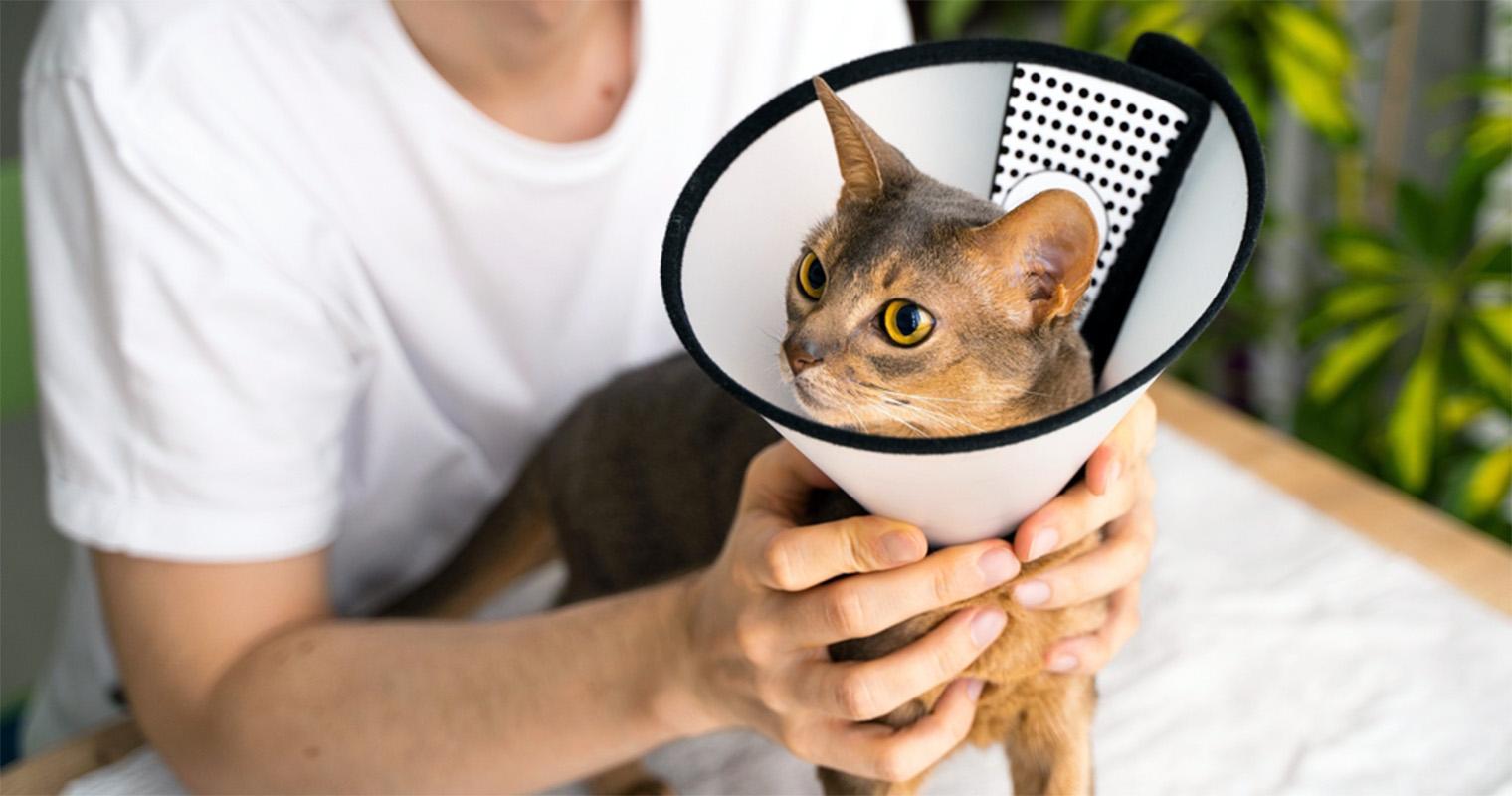Should You Spay or Neuter Your Cat? (Spoiler Alert: Yes.)
Here is why spaying or neutering your cat is important, and what to expect.
Here is why spaying or neutering your cat is important, and what to expect.
by Katie Koschalk, | March 11, 2024

Garnar / Shutterstock
Among the many decisions new cat parents face — like choosing the right cat food, selecting the best veterinarian, and mapping out optimal litter-box placements — one of the most significant is whether to spay or neuter your kitten or adult cat.
While the idea of surgery might seem daunting, the benefits of these procedures far outweigh any drawbacks. Spaying or neutering your cat reduces health risks, prevents unwanted litters and behavioral issues, helps control the feline population, and promotes a healthier, happier cat. These are all fundamental elements of responsible pet parenthood.
Many cats adopted from shelters and rescues are spayed or neutered before they’re adopted out, but this isn’t always guaranteed. Additionally, individuals who get cats from private individuals may find themselves responsible for spaying or neutering their new kitty.
Let’s dive deeper into why this procedure benefits you, your cat, and the cat population at large.
Spaying a cat is a surgical procedure that involves removing a female cat’s ovaries and uterus. Doing so eliminates the risk of unwanted pregnancies, thereby preventing unintended litters. This curtails the population of homeless cats, alleviates the strain on animal shelters and rescue organizations, and reduces cat euthanasia due to the overcrowding of shelters.
From a health perspective, spaying eliminates the risk of uterine and ovarian cancer. It also significantly reduces the risk of uterine infections (pyometra) and mammary (breast) cancer, especially when spaying is done before a female cat’s first heat cycle. Due to these decreased risks, spayed cats often enjoy a healthier, longer life — 39 percent longer according to one large study.
Health benefits aside, you can also expect to see some positive behavioral changes. Spaying eliminates behaviors associated with “heat,” the fertile phase of a female cat’s reproductive cycle that non-spayed cats experience multiple times annually. Cats in heat may vocalize, excessively roll around, rub against objects, attempt to escape outdoors in search of mates, and sometimes urine-spray indoors to attract potential partners.
Because spaying prevents these behaviors, it also means you’re far less likely to have stray male cats come knockin’ on your door, seeking to mate with your female cat.
Some cat parents have expressed concerns about whether their cat’s general personality will change after being spayed, but experts say this is a myth.
Neutering a cat involves the surgical removal of a male cat’s testes. As with spaying, this procedure prevents the occurrence of unwanted litters. Neutering also eliminates the risk of developing testicular cancer and significantly reduces the risk of prostatitis (inflammation of the prostate).
Additionally, neutered male cats who have outdoor access are less likely to get into altercations with other cats over territory and potential mates. These scuffles can cause scratch and bite wounds that can get infected or spread FIV (Feline Immunodeficiency Virus) and FeLV (Feline Leukemia Virus).
As with spaying, you’ll likely notice several positive behavioral changes after your cat is neutered. However, individual cats may respond differently to neutering, and not all of the following behavioral changes will occur in every cat.
Reduced Roaming: Neutered cats are less likely to wander far from home to seek a mate. This can help keep them safe from outdoor hazards, such as traffic, predators, and fights with other animals.
Decreased Aggression: Neutering can reduce aggressive behaviors, such as fighting with other male cats over territory or mates.
Decreased Marking: Neutering often reduces or eliminates spraying behavior, in which male cats mark their territory with urine.
Reduced Sexual Behavior: Neutered male cats typically exhibit less mounting, yowling, and other mating-related behaviors.
Increased Affection: Some cats may become more affectionate after neutering. They may seek out more social interaction with their human family and be more willing to cuddle and be handled.
In most cases, you can spay or neuter your cat at any point in their life. But there’s an ideal window that offers the greatest benefits.
Ideally, spaying should be done before a cat’s first heat cycle — typically around five months old — but it's generally considered safe as early as eight weeks. Spaying before the first heat cycle offers the greatest health benefits, particularly for reducing the risk of mammary cancer. (Cats spayed before their first heat cycle have a mere 0.5 percent chance of developing mammary cancer later in life.) In unspayed cats, each heat cycle increases their risk of developing this cancer. After about 2.5 years of age, spaying offers no protective benefit against mammary cancer.
Spaying before the first heat cycle also prevents unintended pregnancies (which can occur as early as four months of age). However, the exact age for spaying may vary on individual circumstances and veterinary recommendations.
Neutering a male cat is recommended before he reaches sexual maturity, typically around five months of age. Neutering at this age helps prevent unwanted litters and mating behaviors, such as roaming, spraying, and aggression. The exact age for neutering may vary based on factors such as health status and veterinary advice.
While it’s better to have cats neutered or spayed before sexual maturity, it’s never too late to consider these procedures. Even older cats can benefit from neutering or spaying, to prevent unwanted litters and certain health issues.
However, as cats age, they may be at higher risk for complications during anesthesia and surgery. That’s why it’s essential to consult with your veterinarian to assess the risks and benefits of the procedure for your cat, based on their age, health status, and other factors.
So, your cat has undergone the procedure — what happens next? Here’s what to expect.
After the procedure, your cat will be monitored by the veterinary staff to ensure a full recovery from anesthesia. Most cats can go home the same day as their procedure, and are usually given pain medication and an e-collar to prevent them from chewing or licking their incision.
Once home, you might notice that your cat is sleepy, lethargic, and a bit disoriented due to the effects of anesthesia. Don’t worry — these effects typically resolve within 24 to 48 hours.
Your cat may experience mild discomfort or tenderness at the incision site for a few days. You might notice them moving more slowly or exhibiting lower energy levels than usual — although some cats might try to return to their zoomies and playful antics ASAP. All of the above is normal.
Your veterinarian will provide you with post-operative instructions. They may involve asking you to…
Keep your cat indoors and away from active play for a few days, to prevent injury to the surgical site.
Monitor the incision site for signs of infection, such as redness, swelling, or discharge. (Call your vet ASAP if you notice these signs.)
Limit your cat’s activity level, and provide a quiet, comfortable space for them to rest and recover.
Administer any prescribed medications, such as pain relievers or antibiotics, as directed.
The healing time for spaying or neutering can vary depending on factors such as your cat’s age and overall health. But in general, most cats fully recover within seven to 10 days. During this time, you should notice a gradual improvement in your cat’s comfort and energy levels.
When it comes to getting the job done, you have a few options:
Veterinary clinics: Spaying and neutering are common procedures performed by regular, local veterinary clinics.
Animal shelters: Many animal shelters provide spay/neuter services at reduced rates or through subsidized programs.
Low-cost spay/neuter clinics: Dedicated spay/neuter clinics often offer discounted rates for the procedure.
Community programs: Some communities organize spay/neuter events or programs aimed at reducing the number of stray and feral cats. These programs may offer free or heavily discounted services for eligible cat parents.
Mobile clinics: Mobile spay/neuter clinics may travel to different locations, providing convenient access to the procedure for pet parents in various areas.
With a little Googling, it’s fairly easy to research your options to find a provider that suits your budget and preferences.
Spaying/neutering at a local veterinary clinic typically costs $200 to $500. The cost of spaying or neutering your cat varies depending on: your location, the type of facility where the procedure is performed, and if your cat has any health conditions that would make the procedure more intensive.
Many communities also have low-cost spay/neuter clinics or programs that offer more affordable options for pet parents. These clinics may provide the procedure at reduced rates, making it accessible to more individuals. Prices typically range from $50 to $200, depending on location. Additionally, some humane societies, rescues, and other animal shelters offer spay/neuter services at discounted rates.
Before adopting a cat, consider your lifestyle, your living situation, the time commitment, and the financial responsibility, including the cost of medical care like spaying or neutering. Cats can live more than 15 years, so make sure you’re prepared for long-term care, companionship, and providing a safe, loving home.
Before you spay or neuter your cat, the ASPCA strongly recommends that you first get them their core vaccines, if they haven’t had them yet. This will likely include rabies, feline leukemia virus, and a combination shot (a.k.a feline distemper) that protects against feline calicivirus, feline rhinotracheitis, and feline panleukopenia virus. Discuss the vaccine schedule at your cat’s first vet visit.
Although the likelihood of complications in healthy, young cats is generally low, they can still occur. Potential postoperative issues may include inflammation or infection at the incision site, opening of the incision, or swelling beneath the skin around the incision area.
Ready to welcome a new cat into your home? Check out Adopt a Pet’s customizable search tool to find your new family member.
Cat Behavior and Training: Cat Neutering and Behavior
Cat Spay/Neuter: What to Expect and Why It’s Important
Feline Fix by Five: Spay-Neuter Cats by Five Months of Age
Is There an Optimal Time to Spay or Neuter a Cat?
The Optimal Age for Spay/Neuter: A Critical Analysis of Spay Neuter Literature
Recommendations for New Kitten Owners
State of Pet Health 2013 Report

Katie Koschalk is a freelance writer based in Northern California. Fusing her love and knowledge of animals with her journalism degree and years of professional writing, Katie is dedicated to improving the lives of pets and their caretakers by sharing helpful and accurate information. When she’s not at her desk, you can find her exploring trails with her Aussie, Hunter, cooking plant-based meals, and talking to her two cats, Jax and Sadie, in really ridiculous voices.

Breed Info

Adoption Advice

Adoption Advice

Rehome
These many signs will indicate that a vet visit is in order for a possible litter of kittens.